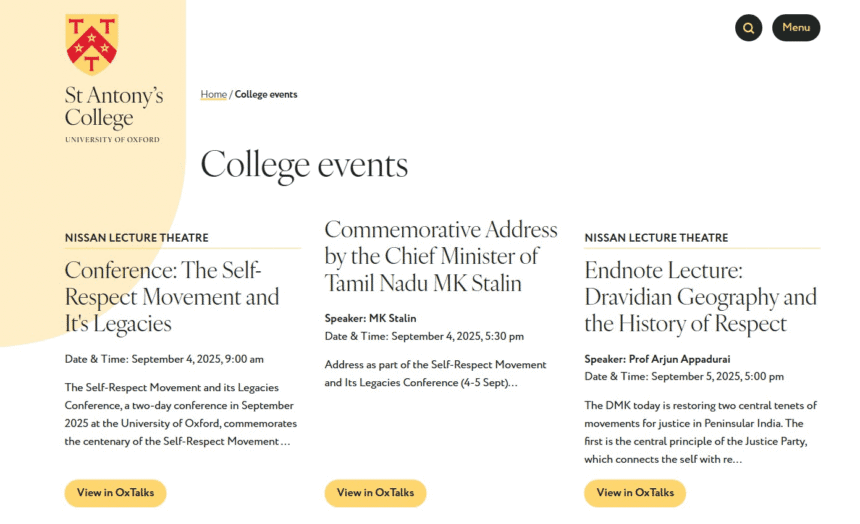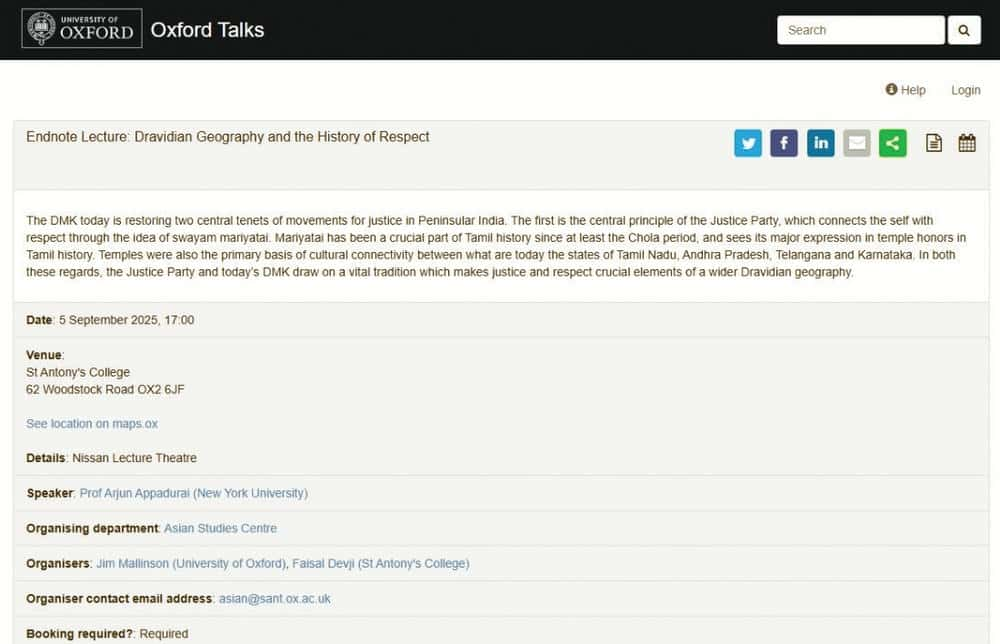
Tamil Nadu Chief Minister M.K. Stalin will deliver a special address at a seminar to be held at Oxford University in London on 04.09.2025 to unveil the film Father Periyar.

The news published by Dinamalar regarding this under the title ''E.V.R. film opening after paying Rs. 25,000 rent'' is given below.
"When I saw Chief Minister Stalin's announcement that E.V. Ramasamy was absent from Oxford University, I inquired with the university's PRO and friends. 'Oxford' University did not officially invite Chief Minister Stalin; E.V. Ramasamy was absent from Oxford University either," it said. Small halls are available for rent for 210 pounds to hold seminars on the Oxford University campus.

Anyone can rent such small halls and hold a program. Since Chief Minister Stalin is coming to Britain, DMK members have rented a small hall in the Oxford University campus. Stalin has announced that he will open the film E.V. Ramasamy there. This has nothing to do with Oxford University.
Dinamalar reported that someone said this.
The Purattu Malar, which advertises its magazine as 'The Stone of Truth', should have at least searched the internet before publishing this news. But, Dinamalar, which operates with the 'Taraka Mantra' that 'Before the truth goes around once, a rumor goes around a hundred times', and the 'IT Wing' of the Hindutva gang have decided to spread lies and distortions on social media and in the press and have been spreading this false news since yesterday (30.8.2025) with the aim of defaming Father Periyar and Chief Minister M.K. Stalin.

This is the truth! This Self-Respect Movement Centenary Conference is an event jointly hosted by St. Anthony's and Balliol College, Oxford University.
This is also stated on the website of St. Anthony's College,
Details have also been published on the Oxford University website (their link and image are provided here).
The links in the Oxford Talks section of the official website of the University of Oxford list the event as being coordinated
by St Antony’s College, 62 Woodstock Road OX2 6JF, its Asian Studies Centre as the coordinator, the names of the coordinators
as Jim Mallinson (University of Oxford), Faisal Devji (St Antony's College), the official email address of the department, and a link to register to participate in the event. Similarly, a link to the event in which the Chief Minister of Tamil Nadu will participate on the evening of September 4, and a link to the continuation of the seminar to be held the next day, have been provided separately.
So, is it the duty of Ava's Patrika to publish the hoax of a prominent person who fled from the DMK and recently joined the BJP, saying, "This is not a Daavata party, it is a Dharaniyile"?
- Liberatio (viduthalai) Daily, 31.08.25

Tamil Nadu Chief Minister M.K. Stalin will deliver a special address at a seminar to be held at Oxford University in London on 04.09.2025 to unveil the film Father Periyar.

The news published by Dinamalar regarding this under the title ''E.V.R. film opening after paying Rs. 25,000 rent'' is given below.
"When I saw Chief Minister Stalin's announcement that E.V. Ramasamy was absent from Oxford University, I inquired with the university's PRO and friends. 'Oxford' University did not officially invite Chief Minister Stalin; E.V. Ramasamy was absent from Oxford University either," it said. Small halls are available for rent for 210 pounds to hold seminars on the Oxford University campus.

Anyone can rent such small halls and hold a program. Since Chief Minister Stalin is coming to Britain, DMK members have rented a small hall in the Oxford University campus. Stalin has announced that he will open the film E.V. Ramasamy there. This has nothing to do with Oxford University.
Dinamalar reported that someone said this.
The Purattu Malar, which advertises its magazine as 'The Stone of Truth', should have at least searched the internet before publishing this news. But, Dinamalar, which operates with the 'Taraka Mantra' that 'Before the truth goes around once, a rumor goes around a hundred times', and the 'IT Wing' of the Hindutva gang have decided to spread lies and distortions on social media and in the press and have been spreading this false news since yesterday (30.8.2025) with the aim of defaming Father Periyar and Chief Minister M.K. Stalin.

This is the truth! This Self-Respect Movement Centenary Conference is an event jointly hosted by St. Anthony's and Balliol College, Oxford University.
This is also stated on the website of St. Anthony's College,
Details have also been published on the Oxford University website (their link and image are provided here).
The links in the Oxford Talks section of the official website of the University of Oxford list the event as being coordinated
by St Antony’s College, 62 Woodstock Road OX2 6JF, its Asian Studies Centre as the coordinator, the names of the coordinators
as Jim Mallinson (University of Oxford), Faisal Devji (St Antony's College), the official email address of the department, and a link to register to participate in the event. Similarly, a link to the event in which the Chief Minister of Tamil Nadu will participate on the evening of September 4, and a link to the continuation of the seminar to be held the next day, have been provided separately.
So, is it the duty of Ava's Patrika to publish the hoax of a prominent person who fled from the DMK and recently joined the BJP, saying, "This is not a Daavata party, it is a Dharaniyile"?
- Liberatio (viduthalai) Daily, 31.08.25







